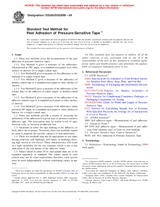Wir benötigen Ihre Einwilligung zur Verwendung der einzelnen Daten, damit Sie unter anderem Informationen zu Ihren Interessen einsehen können. Klicken Sie auf "OK", um Ihre Zustimmung zu erteilen.
ASTM D3330/D3330M-04
Standard Test Method for Peel Adhesion of Pressure-Sensitive Tape
NORM herausgegeben am 1.10.2004
Informationen über die Norm:
Bezeichnung normen: ASTM D3330/D3330M-04
Anmerkung: UNGÜLTIG
Ausgabedatum normen: 1.10.2004
SKU: NS-23309
Zahl der Seiten: 6
Gewicht ca.: 18 g (0.04 Pfund)
Land: Amerikanische technische Norm
Kategorie: Technische Normen ASTM
Die Annotation des Normtextes ASTM D3330/D3330M-04 :
Keywords:
adhesion to backing, adhesion to liner, peel adhesion at 90°, angle, peel adhesion at 180°, angle, pressure sensitive tape, ICS Number Code 83.180 (Adhesives)
Ergänzende Informationen
| Significance and Use | ||||||||||||||||||
|
These test methods are tools for quality assurance use. Given specific pressure-sensitive tape and a requirement in terms of the minimum or maximum peel value expected for this tape, the data from the test can be used in conjunction with acceptance criteria. Test Method A, B, C, E, or F can show the relative bond strength of a given tape to one or more surfaces (material and texture) as compared to the standard stainless steel panel. Substitution of representative samples of materials in question for the standard steel panel would suffice to do this. Test Methods A, B, C, E or F cannot be used to compare two pressure-sensitive tapes of the same type but of different manufacture for their ability to adhere to a surface. This is because the measured peel force is not normalized for a fixed area of stress. The area under stress varies with backing stiffness and adhesive rheology (firmness). Two different tapes seldom agree in these properties. Test Method D can show the amount of force required to remove a liner that covers the adhesive side of a tape at a specified peel rate. The force will be different at other peel rates. These test methods may not provide design information as there is usually no direct relationship between peel adhesion and any functional requirement. |
||||||||||||||||||
| 1. Scope | ||||||||||||||||||
|
1.1 These test methods cover the measurement of the peel adhesion of pressure-sensitive tapes. 1.1.1 Test Method A gives a measure of the adherence, when peeled at 180 angle, to a standard steel panel or to other surface of interest for a single-coated tape. 1.1.2 Test Method B gives a measure of the adherence to the backing of a single-coated tape. 1.1.3 Test Method C gives a measure of the adherence of double-coated tape to a standard steel panel or other surface of interest. 1.1.4 Test Method D gives a measure of the adherence of the release liner to the adhesive of either single- or double-coated tape. 1.1.5 Test Method E gives a measure of the adherence of an adhesive transfer tape to a standard steel panel or other surface of interest. 1.1.6 Test Method F gives a measure of the adherence, when peeled at 90 angle, to a standard steel panel or other surface of interest for a single-coated tape. 1.2 These test methods provide a means of assessing the uniformity of the adhesion of a given type of pressure-sensitive adhesive tape. The assessment may be within a roll of tape, between rolls, or between production lots. 1.3 Variations in either the tape backing or the adhesive, or both, affect the response. Therefore, these test methods cannot be used to pinpoint the specific cause(s) of non-uniformity. 1.4 These test methods may not be appropriate to test tapes having relatively stiff backings, stiff liners, or backings showing high stretch at low forces. These characteristics will result in a high variability for the test response which is not a true indication of the real nature of the adhesive bond. 1.5 Values stated in either SI or inch-pound units are to be regarded separately as standard. The values stated in each system may not be exact equivalents, therefore, each system must be used independently without combining values in any way. This standard does not purport to address all of the safety concerns, if any, associated with its use. It is the responsibility of the user of this standard to establish appropriate safety and health practices and determine the applicability of regulatory limitations prior to use. |
||||||||||||||||||
| 2. Referenced Documents | ||||||||||||||||||
|
Empfehlungen:
Aktualisierung der technischen Normen
Wollen Sie sich sicher sein, dass Sie nur die gültigen technischen Normen verwenden?
Wir bieten Ihnen eine Lösung, die Ihnen eine Monatsübersicht über die Aktualität der von Ihnen angewandten Normen sicher stellt.
Brauchen Sie mehr Informationen? Sehen Sie sich diese Seite an.




 Cookies
Cookies
